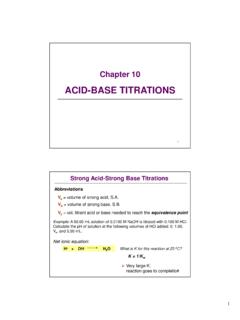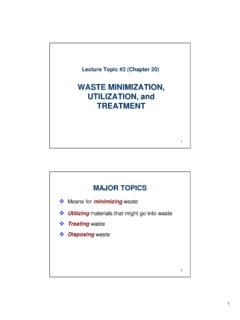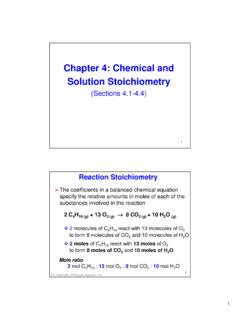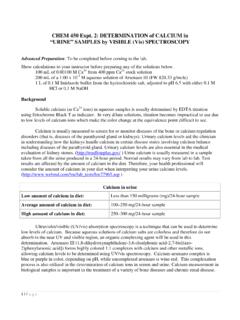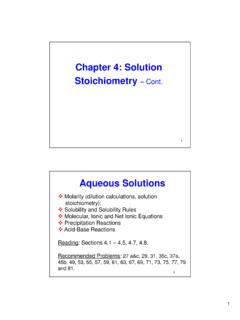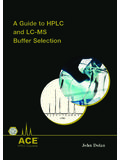Transcription of HIGH PERFORMANCE LIQUID CHROMATOGRAPHY (HPLC)
1 1 high PERFORMANCELIQUID CHROMATOGRAPHY ( hplc )Chapter 28 NOTE: hplc came about because not allcompounds can be vaporizedand analyzed on a GCSource: Harris, Exploring Chemical Analysis, 2nded. (2001) 2 Summary of MethodMobile phase: LiquidHigh PERFORMANCE LIQUID CHROMATOGRAPHY ( hplc ) An analytical separation technique that involves the high -pressure flow of a LIQUID through a column that contains the stationary phase: Can be a solid (LSC) or a LIQUID (LLC) A mixture of compounds injected at one end of the column separates as the compounds pass through. Separated compounds are detected electronicallyas they elute at the other end of the with GCGCHPLCB asis of separationInteractionof solutes with the ; solute vapor pressureInteractionof solutes with boththe and timeFast(a few minutes for simple mixtures)Slower than GC (several minutes for a simple mixtureTemperature for separationUsually requires a high temperature(>40 0C)Usually a room temperature techniqueApplicationsSeparation of volatileand thermally stablecompounds - cannot be used for high MW and highly polar compoundsSeparation of a wider range of compounds -- high MW, polar, and ioniccompoundsParameter3 InstrumentationInstrumentation(Cont.))
2 1)Solvent or mobile phaseMajor components Usually a mixture of an organicsolvent (Ex. methanol, IPA) and water Sometimes buffered- keeps solutes in electrically neutral form Solvent polarityaffects the separation processMobile phase considerations Must be filtered(to prevent tiny solids from depositing at the column head) and degassed Degassing is done by helium sparging Bubbles could interfere with detection4 Role is to pump the solvent at a high pressure (usually from 1000 to 6000 psi) through the packed columnInstrumentation(Cont.)2. PumpInstrumentation(Cont.)3. Sample introduction system Usually a loop injector see image below Introduces the injected sample to the flowing mobile phase Automated injectors are common5 A small metal tube (typically 5 to 30 cm long; 1-5 mm ) that contains the stationary phaseInstrumentation(Cont.
3 4. Column Role is to separate the components of a mixtureColumn Cont. Much shorter than columns used in GC --- Why? Highly efficient separationsachieved in hplc due to interactions of both and with the components of a mixture vs. GC, where only the interacts with components No need for long columns6 Instrumentation(Cont.)5. Detector Different design from those of GC detectors because the components are dissolved in a (vs. gas in GC)Detectors detectors most commonUV absorption cell for hplc Applications: Respond to substances that absorb light in the range 180 to 350 nm Z-shaped flow cell - > more time for UV light to pass th/ systems (aromatics, alkenes, alkynes) Carbonyls Most organics7 Mass spectrometric detectors in LCMS Challenges: (1) Converting LIQUID column effluent to gas (Recall: MS is a gaseous phase technique) and (2) removing a lot of solvent before entering MS Use of nanoscale capillary LC flow rates of L/minElectrospray ionization**Similar to a nebulizer, but uses an electrode and high voltage to form fine, charged dropletsHPLC Column SelectionDependent on the.
4 (1)type of mixturebeing separated, and (2)type of interactionwith the Uses normal phase columns1)Normal phasechromatographyutilizes a:Two kinds of LIQUID CHROMATOGRAPHY based on the type of mixturebeing separatedApplication: Separation of polarcompounds(amino acids and peptides, alcohols, carboxylic acids) Has its origin in older LSC, which utilized polar silica or alumina Made of polarstationary phasebonded to a solid supportCalled bonded phase polar nonpolar of polar bonded (stationary) phases:Examples of nonpolaror low polarity mobile phases Hydrocarbons, such as hexane(C6H14) and toluene(C7H8) Chloroform, CHCl392) Reverse phasechromatography-utilizes a: Uses reverse phase columns= contains nonpolarbonded phase C18 Octyl= C8 nonpolar polar : Separation of nonpolarcompoundsExample of nonpolar bonded (stationary) phases:Example of polar mobile phasesReverse phase CHROMATOGRAPHY (Cont.
5 Hydrocarbons (with C8and C18; most common) A mixture of water and an organic solvent (methanol, acetonitrile)Note: Bonded phases are usually attached to a silicaor silica-based solid supportSilica w/ reactive silanol (Si-OH) groupsReplacement of silanol group w/ R groups to produce bonded phases10 Selection of Mobile PhaseEluent strength= ability of the to elute a solute from the column eluent strength by polarity of the Reverse phase CHROMATOGRAPHY eluent strength by polarity of the Normal phase CHROMATOGRAPHY Increased by approaching the polarity of the ( by competing w/ the for the solute) Results to better elution of components at a shorter analysis timeQ. What changes can be done to increase the eluent strength in hplc ?
6 In practice: Add a miscible, more polarsolventIn practice: Add a miscible, less polarsolventIncreasing eluent strength(Cont.)Answer:Drill: Arrange the following solvents in the order of increasing polarity. Acetonitrile; hexane; water; methanol; isopropyl alcoholHexane < Acetonitrile < Isopropyl alcohol < Methanol < WaterIncreasing eluent strength(Cont.) Normal phase CHROMATOGRAPHY => Increase proportion of water or methanol, or Reverse phase CHROMATOGRAPHY => Decrease proportion of water or methanol decrease amount of hexane (becomes more polar)111. Column length effectEffect of other parameters on retention of solutes length, tR analysis time2. Polarity of the Polar solutesare more soluble (more retained) in polar Mobile phase flow flow rate, tR= analysis time Increase flow rate, and/or Increase eluent strength, and/or Use a shorter column => last resortQ.
7 How would you decrease tRof strongly retained solutes?4. Polarity of mobile phase Polar elutes polar components faster; Nonpolar elutes nonpolar components fasterEffect of other parameters .. 12 As the polarity of the approaches that of the , tRdecreases due to increased eluent strengthIncreasing polarity of polarity of of other parameters on retention of solutes(Cont.)5. Nature of bonded Retention increases as chain length increases13 Challenge: What kind of samples would contain these compounds?14 Applies to the separation of more complex mixturesSolvent composition in HPLCISOCRATIC vs. GRADIENT ELUTION Analogous to isothermal vs. programmedtemperature in GC in terms of outcomeIsocratic elution Uses a constant solvent compositionthroughout the separation process Ideal for the separation of simple mixturesGradient elution Solvent composition is changedin time (by increasing eluent strength)Gradient elution Improved separation within a much shorter timeIsocratic Elution of chlorinated benzenes on a C18column Poor resolution of early-eluting solutes Extremely long tRof late-eluting solutesIsocratic elutionSource: Skoog, Holler and Nieman, Principles of Instrumental Analysis.
8 5th ed., Harcourt Brace,1998.


